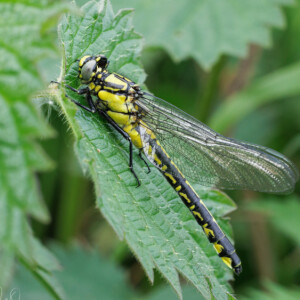Beauty and the beast
"Oh, there you are, Beautiful!" I said. "I thought I'd lost you. Thanks for hanging around." I admit to having looked over my shoulder quickly to make sure no-one else was in earshot, but I make no apology for talking to my subjects. I think if you're going to stress out an insect by sticking a large camera lens in its face, the least you can do is buy it a drink speak gently and politely to it, and do your best to look as little like a predator as possible.
A friend recently posted some excellent Odonata images he'd taken along the bank of the River Severn at Severn Stoke, which was somewhere I'd never been, and as it's reasonably close to home I decided to drive over this morning and check it out. The weather wasn't especially good for Odonata, or macro photography, being overcast and windy, and I didn't have much time to spare, but I still landed a good catch: Beautiful and Banded Demoiselles, and a lone, stolid Common Clubtail, as well as mayflies, beetles, and plenty of other tiny delights.
I'm featuring this female Beautiful Demoiselle because she's gorgeous, obviously, but also because I learned something new recently that I thought it would be helpful to share. While it's very easy to distinguish male Banded and Beautiful Demoiselles by the wing colouration, the females are all some shade of green and/or gold, and can be quite hard to tell apart. The false wing spot of the female Beautiful Demoiselle is further along the fore edge of the wing than in her Banded cousin, but that's only really useful if you have one of each to hand for comparison purposes, and in any case, some Beautiful females have no wing spot at all. But the Worcestershire County Recorder mentioned recently in his blog that Beautiful Demoiselle larvae can be distinguished by little spiky pegs behind their eyes, and that these persist in the adult damselfly - and sure enough, if you check out this photo full-screen, there they are. In the larvae they're big enough to look like backward-pointing horns, but in adults they're reduced to small bumps on the back of the head - though interestingly, in all my photos they give the impression of being a different colour than the surrounding cuticle, so they're pretty obvious once you get your eye in. I think this is a very helpful identification aid, and I wish I'd known about it sooner.
My second photo tonight is a shot of the female Common Clubtail, who sat unmoved and unmoving through all my attentions towards her. I think it has to be admitted that Common Clubtails are not among the most beautiful dragonflies in the world, though my headline is probably a little harsh. But what they lack in glamour they make up for in scarcity. I was going to say "much like myself" here, but unlike this dragon I'm not actually red-listed, while the Common Clubtail was listed as Near Threatened back in 2008, after a significant decline in its numbers along the River Severn. The main threats to its survival are pollution, dredging, deforestation along river banks, and recreational use of rivers during its emergence period. The wash from fast river craft is especially dangerous to the emerging larvae, because they often use structures such as bridge supports and the uprights of jetties and fishing pegs to leave the river, and eclose just above the normal water level. This is why I never see a Common Clubtail without being slightly amazed that it managed to make the perilous journey from river to bank unscathed, and why, when I finally gave up waiting for this one to open her wings for me, I said a respectful goodbye, thanked her for her patience, and wished her a long and successful breeding season.
There are a few more Severn Stoke photos here, if you'd like to see them.


Comments
Sign in or get an account to comment.


